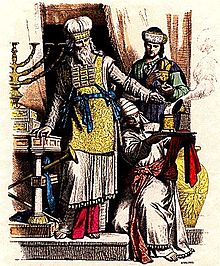Priestly turban
| Part of a series of articles on |
| Priesthood in Judaism |
|---|
| |
|
Priestly covenant |


The priestly mitre or turban (Hebrew: מִצְנֶפֶת, romanized: miṣnep̄eṯ) was the head covering worn by the High Priest of Israel when he served in the Tabernacle and the Temple in Jerusalem.
Etymology
The Hebrew term for the priestly turban has been translated as "mitre" (KJV) or "headdress". It was most likely a turban, as the word comes from the root "to wrap".
Hebrew Bible
The turban worn by the High Priest was much larger than the head coverings of the priests. It was wound so that it formed a broad, flat-topped turban, resembling the blossom of a flower.[citation needed] The head covering of the priests was different, being wound so that it formed a cone-shaped turban, called a mīgbāʿā (מִגְבָּעָה). It was made of fine linen in Exodus 28:39, and like all the holy garments, it was made by "gifted artisans ... filled with the spirit of wisdom" according to Exodus 28:3. Rashi writes that the High Priests' turban was identical to the turbans of the other priests.[a]
The priestly golden head plate (Hebrew: צִיץ, romanized: ṣīṣ, lit. 'blossom, flower') was attached to the turban using two sets of blue cords: one going over the top of the head and the other around the sides of the head at the level of the ears according to Exodus 39:31.
Talmud
According to the Talmud, the wearing of the turban atoned for the sin of arrogance on the part of the Israelites according to Zevachim 88b.
See also
- Ephod
- Priestly breastplate
- Priestly robe (Judaism)
- Priestly sash
- Priestly tunic
- Priestly undergarments